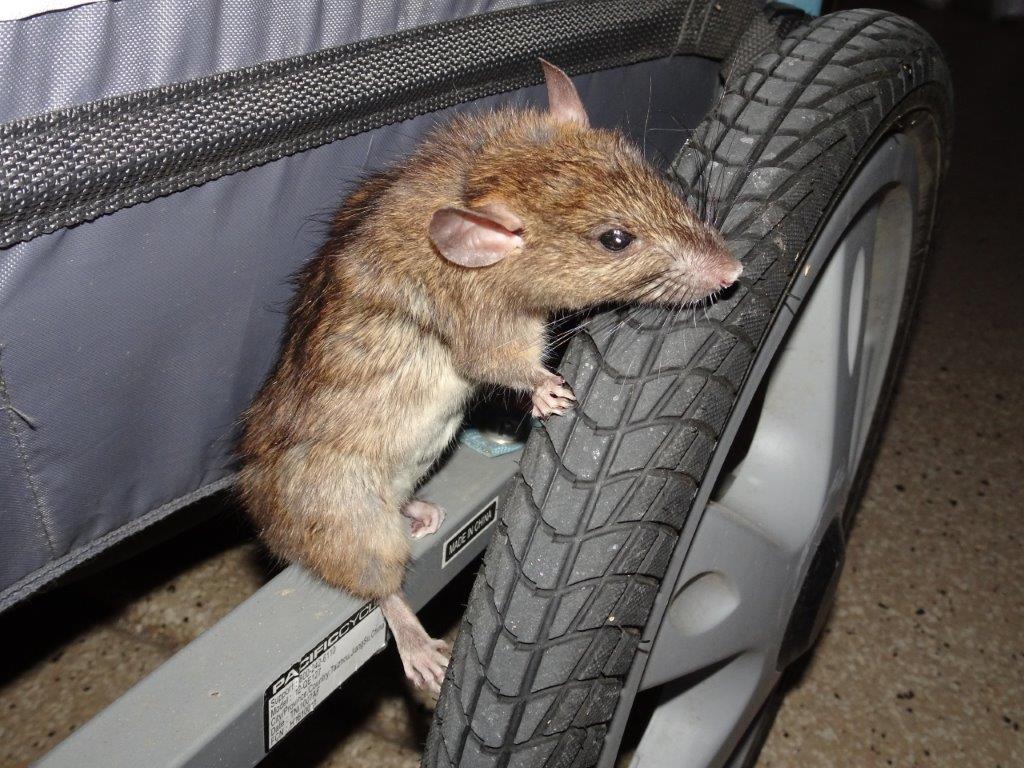Although they are considerably better at the long jump rather than the high jump, rats are actually extremely well skilled when it comes to jumping around. They are naturally quite curious creatures, always exploring their surroundings, and they are energetic too, often running much quicker than your eyes can watch after them.

Whilst judging the distance between the two points, you will often spot a rat stood up on its hind legs, much like a meerkat would. They will then bob their head up and down, usually many times over, and this is to try and gauge the distance. They are using this action to work out how much oomph they need to put into their jump in order to make it to where they want to go.
It is the back legs of the animal that propels them, but they will often land rather gracefully than you'd think - front paws first, the back paws following suit. Rats that are packing on the pounds - those that have found a steady food source - may not be able to jump as high, or as long either, but they can still perform quite the jump when necessary.
Not just great at jumping, rats are also very good swimmers, great climbers, and great at digging and clawing too. During the winter months, these skills make life easier for them, the rats often trying to break into residential and commercial properties in a bid to find warmth, shelter, food and also a source of fresh, clean water to drink. They will often look for the foods that contain the most sugar and carbohydrates, as they sense that this will give them the most energy, but they are scavengers and will eat practically everything and anything.
Bearing that in mind, when it comes to protecting your home from jumping / climbing / swimming / digging rats, you should first ensure that you are not setting out any food for them to eat. This could be leftovers in the trash can, dog or cat food left out for your beloved household pets, and even bird feed too. If there is food somewhere, they will sniff it out, and once they sniff it out and get their teeth around it, they won't be so easy to shift.
Clearing up after yourself is a good idea too - clutter is often what draws these rodents and other wild animals in, offering a source of shelter and warmth. Once they snuggle in to those messy debris piles in your back yard, it won't be long before they're sniffing out your home - your kitchen perhaps? Making your home as unattractive as possible is the way to ensure rats don't enter your home, and also protecting your home by making sure all areas of damage are repaired, and all holes are sealed.
Go back to the Rats in the Attic home page.

Rats are a frustratingly hardy species of rodent that have been around for over 66 million years, and they owe much of their survivability to their impressive agility and adaptability. Since the dawn of humanity, rats have been a pest to humans and have shown a supernatural power to thrive in even the worst of circumstances.
Part of the problem is that they can eat just about anything, whether it is fit for human consumption or otherwise, giving them a varied diet unrivaled by many other creatures for them to feed off. They also do not need to drink much water to survive, although they do need to drink it daily.
Rats are excellent burrowers. This means they are able to make nests in a lot of places, especially underneath or even inside houses, to the irritation of homeowners all over the world. They also make decent swimmers, with some species of rats living in swamp areas having adapted to prefer hunting in the water.
Like many other rodents, rats are also adept climbers, able to scale walls with relative ease, including the network of pipes inside your home’s walls. If you have rats in your attic, chances are they got in through the roof or the eaves of your home by climbing up a nearby tree and jumping from it.
Rats do in fact have the ability to jump, also this ability can vary drastically depending on the species. In general, rats are able to jump both vertically by as much as 3 feet and horizontally about 4 feet, so it is no surprise they can so easily get into our attics from trees or overcome fences lower than 3 feet in height. But this also explains why it can be difficult to trap rats.
For example, if you place a trap along a path that rats use frequently, they will most likely leap over it, provided there is space for them to do so. This is because they are intelligent creatures with excellent memories, meaning they will recognize something new and unfamiliar on a route they regularly use and take steps to avoid it.
In another testament to their survivability, rats can also reportedly fall from a height of as much as 40 feet and not sustain any significant injuries. However, rats are only ever likely to use their ability to jump to gain access to our homes or scale fences. Only domesticated rats, such as those kept as pets, will ever jump towards a human.








